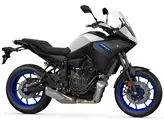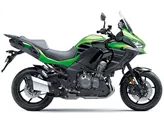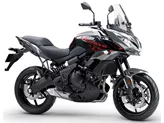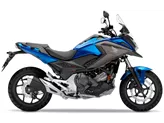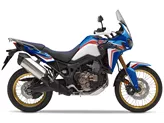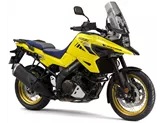Kawasaki Versys 1000 2016 vs. Kawasaki Versys 650 2016

Kawasaki Versys 1000 2016

Kawasaki Versys 650 2016
Overview - Kawasaki Versys 1000 2016 vs Kawasaki Versys 650 2016
The Kawasaki Versys 1000 2016 and the Kawasaki Versys 650 2016 are both enduro motorcycles that offer different features and performance levels.
Starting with the engine and drive train, the Versys 1000 has a more powerful in-line four-cylinder engine with a displacement of 1043ccm, producing 120 HP and 102 Nm of torque. On the other hand, the Versys 650 has a smaller in-line two-cylinder engine with a displacement of 649ccm, producing 69 HP and 64 Nm of torque. This means that the Versys 1000 offers more power and acceleration compared to the Versys 650.
In terms of suspension, both motorcycles feature upside-down telescopic forks at the front. However, the Versys 1000 offers more adjustment options for the front suspension, including compression, preload, and rebound adjustments. The Versys 650 only has rebound adjustment for the front suspension. For the rear suspension, both motorcycles offer rebound adjustment.

Kawasaki Versys 1000 2016
In terms of chassis, the Versys 1000 has an aluminum frame, which provides stability and durability. On the other hand, the Versys 650 has a steel frame, which may not be as lightweight or rigid as the aluminum frame.
Both motorcycles have double disk brakes at the front, providing strong and reliable stopping power. The front tire diameter is 17 inches for both motorcycles, but the Versys 1000 has a wider rear tire width of 180mm compared to the 160mm of the Versys 650. Both motorcycles have a 17-inch rear tire diameter.
In terms of dimensions and weights, the Versys 1000 has a longer wheelbase of 1520mm compared to the 1415mm of the Versys 650. Both motorcycles have a seat height of 840mm, but the Versys 1000 is heavier with a kerb weight of 250kg (with ABS) compared to the 216kg (with ABS) of the Versys 650. Both motorcycles have a fuel tank capacity of 21 liters.

Kawasaki Versys 650 2016
Moving on to the strengths of each motorcycle, the Versys 1000 offers a sporty look, comfortable seating position, powerful and cultivated engine, adjustable windshield, stable chassis, well-controlled braking system, clever range of accessories, and a comparatively low price. On the other hand, the Versys 650 offers adjustable brake and clutch levers, a wide range of use, a 21-liter fuel tank, and a sporty look.
However, both motorcycles have their weaknesses. The Versys 1000's windshield can only be adjusted when stationary, and the gear indicator costs extra. The Versys 650 has narrow handlebars, can feel somewhat sluggish in bends, and has a high seat.
In summary, the Kawasaki Versys 1000 2016 offers more power, adjustability, and a sporty look, while the Kawasaki Versys 650 2016 provides a wide range of use, adjustable levers, and a larger fuel tank. Ultimately, the choice between the two motorcycles depends on the rider's preferences and intended use.
Technical Specifications Kawasaki Versys 1000 2016 compared to Kawasaki Versys 650 2016
Pros and Cons in comparison
Pros and Cons in comparison
Kawasaki Versys 1000 2016

The Kawasaki Versys 1000 is not a completely new model - even if it looks like one from the design point of view. The look has been cleverly adapted to the current aggressive Kawasaki line with two pointed headlights and many edges at the front. Technically, on the other hand, it has been cautiously upgraded - but quite sensibly. Two additional horsepower boost the output to 120 hp, which is excellent to ride thanks to the wonderful in-line four-cylinder characteristics. The chassis corresponds to the sporty demands of a Kawasaki, but the ergonomics and comfortable seating position allow for long journeys - just like a big enduro. With useful accessories such as a pannier set, top case, heated grips and additional headlights, the Versys 1000 becomes a serious long-distance tourer - the comparatively low base price makes these gimmicks quite affordable.
Kawasaki Versys 650 2016

When it was first introduced, the Versys 650 was a refreshing, modern concept that combined lots of fun with a lively in-line two-cylinder engine, high everyday utility and a wide range of uses. In the meantime, it has a few years under its belt and, after the visual update, which is very successful, it also deserves a technical overhaul. While the tank should not shrink, a lower seat height would be desirable.
Price Comparison Avarage Market Price Kawasaki Versys 1000 vs Kawasaki Versys 650
There are a few key differences between a Kawasaki Versys 1000 2016 and a Kawasaki Versys 650 2016. In terms of price, the actual average price of a Kawasaki Versys 1000 2016 is about 47% higher. Compared to Kawasaki Versys 650 2016 there are less Kawasaki Versys 1000 2016 bikes available on the 1000PS.de Marketplace, specifically 7 compared to 10. It takes less time to sell a Kawasaki Versys 1000 with 88 days compared to 101 days for a Kawasaki Versys 650. Since model year 2012 1000PS.de editors have written 19 reviews for the Kawasaki Versys 1000 and 39 reviews for the Kawasaki Versys 650 since model year 2007. The first review for the Kawasaki Versys 1000 was published on 11/7/2011 and now has more than 8,400 views. This compares to more than 3,900 views for the first review on Kawasaki Versys 650 published on 7/25/2006.



